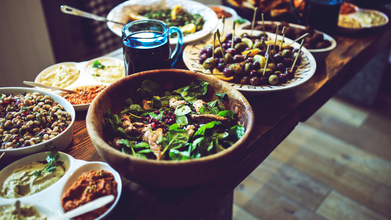- Health Conditions A-Z
- Health & Wellness
- Nutrition
- Fitness
- Health News
- Ayurveda
- Videos
- Medicine A-Z
- Parenting
Breast Milk Ice Cream Hits The Shelves, But Do Adults Really Need It?

Credits: Frida, Canva
Have you heard yet? The Breast milk ice cream by OddFellows and Frida is the hottest talk of the town. While the ice cream is actually not made with real breast milk, the taste is said to mimic it. It is a bit sweet, a bit salty and has hints of honey with a "dash of colostrum", states Frida's website. According to Frida's official press release, the company wanted to answer the question that everyone "secretly wondered": What does breast milk actually taste like?
The Press Release read, as published by People, "The ice cream will be a pitch-perfect representation of the sweet, creamy, nutrient-packed goodness we’ve all wanted to try but have been afraid to ask about. It will include some of the same nutrients — fats (Omega-3 brain fuel!), carbs (energy-boosting lactose), important vitamins (iron, calcium, vitamins B and D, and zinc), plus lots of H2O for hydration."
While the ice cream may not have been made from actual breast milk, many adults consume breast milk for purported health benefits. As per a 2015 study published in the Journal of the Royal Society of Medicine, adults are buying breast milk from online market. It is marketed as "super food" and has emerged as a craze among adults.
The study notes: "While breast milk has long been promoted as optimal for infant nutrition, among CrossFit, BodyBuilding, Palaeo and other fitness communities, fetishists, chronic disease sufferers and even foodies, breast milk is in demand. In the UK, breast milk ice cream is for sale. In the USA, a lollypop company sells a breast milk-flavoured sweet. Primarily, though, the milk is sold in its raw state, ready to drink."
But, is it really that necessary for adults to consume this "super food" made for the babies? Do fitness freak really need breast milk for muscles? To know answers to these questions, we spoke to Ms Edwina Raj, Head of Services, Clinical Nutrition & Dietetics at Aster CMI Hospital, Bengaluru.
Raj says that there is no scientific evidence that breast milk provides unique muscle gain or recovery benefits for adults beyond what regular protein sources offer.
Is Breast Milk For Adults?
"While it [breast milk] contains proteins, carbohydrates, fats, and growth factors ideal for infants, the protein content is relatively low compared to whey, casein, or plant-based protein powders commonly used by athletes. Claims that breast milk boosts performance often stem from its association with growth-promoting compounds for babies, but these do not have the same impact on fully developed adult bodies," explains Raj.
For adults, the muscle gain actually relies on adequate protein intake, balanced diet and proper training.
Do Adults REALLY Need This "Super Food"?
The main claim that makes breast milk so enticing even to adults is that it provides all essential nutrients for one to sustain. However, explains Raj, the nutrients in breast milk can be matched. Though, she agrees that it cannot mimic the benefits of immunonutrients. However, Raj says that other key components like proteins, healthy fats, carbohydrates, vitamins, minerals, and beneficial compounds are all readily available in a balanced diet.
For example, high-quality protein from eggs, dairy, lean meats, legumes, and whey supplements can exceed breast milk’s protein content, while omega-3 fatty acids from fish, flaxseeds, and walnuts offer equal or greater heart and brain benefits. Vitamins and minerals found in breast milk can be obtained from fruits, vegetables, whole grains, and fortified foods. Even immune-supporting and gut-friendly compounds can be obtained through probiotics, prebiotics, and nutrient-rich foods.
Raj says, "[Breast milk] it doesn’t offer any essential nutritional benefits to healthy adults that they can’t get from regular foods or supplements. Its proteins, healthy fats, vitamins, and minerals can all be obtained from a balanced diet, and the immune-boosting antibodies in breast milk are most effective for developing infant immune systems, not fully matured adult ones."
Hygiene Issues
For products like breast milk ice cream, strict hygiene and safety checks are essential to ensure it’s safe for adult consumption.
Raj notes that the donor must be screened for infectious diseases such as HIV, hepatitis B and C, syphilis, and other transmissible illnesses, similar to blood donation protocols.
Although breast milk flavoring ingredient may be of small amount but the milk should be collected using sterile equipment, handled with gloved hands, and stored at safe temperatures to prevent bacterial growth.
"Pasteurization is crucial to kill harmful bacteria and viruses without significantly altering nutritional content. Production facilities must follow food safety regulations, including contamination control, regular microbial testing, and proper labelling," she says.
Consumers should only source such products from regulated, tested suppliers, as untested breast milk can carry serious health risks for adults.
Talking about the breast milk flavoured ice cream, she says, "Breast milk flavored ice cream can shock the consumer yet cannot be superior to what a balanced adult diet can provide, and the immune-boosting properties mainly benefit infants, for its benefit in adults are yet to be studied."
"As long as it’s made under strict safety standards, it can be a quirky treat but not a game-changer in adult nutrition," she says.
Can Your Morning Coffee Raise Your Blood Pressure? Cardiologist Weighs In

Credits: Canva
Americans reach for coffee more often than any other drink, and studies continue to show that a couple of daily cups suit most people and may even support overall health. At the same time, nearly half of U.S. adults live with high blood pressure, defined as a systolic reading above 130 mmHg or a diastolic reading above 80 mmHg.
This raises a natural question. Does caffeine play a part in rising blood pressure levels? Is our strong preference for coffee adding to the problem, or could regular coffee intake possibly help keep blood pressure lower?
Coffee And High Blood Pressure: Is There A Link?
Many people enjoy coffee because it sharpens focus and lifts energy. That same stimulating action is also what can nudge blood pressure upward for a short while. John Higgins, MD, a cardiologist and professor of medicine at UTHealth Houston, agrees that this happens and notes that the general answer is yes. Moderate coffee use is usually acceptable for people whose blood pressure is stable or only slightly raised, though individuals react differently. While caffeine can push readings higher for a brief period, long-term drinking patterns tell another story.
Several studies report no added risk of hypertension among people who drink coffee often. A review of 13 cohort studies found no clear link between coffee intake and the development of high blood pressure. A separate 2023 review even noted that heavier coffee consumption was tied to a 7 percent lower risk of hypertension. The evidence suggests that people who drink coffee regularly tend to build tolerance to caffeine’s short-lived effect on blood pressure.
The 2025 AHA/ACC Hypertension Guideline does not list specific limits for coffee, and the American Heart Association states that moderate amounts appear fine for healthy adults.
How Much Coffee Is Safe To Consume For Blood Pressure Patients?
There is no set rule, but research supports one to three cups a day for most people whose blood pressure is well controlled.
Remember that caffeine levels can vary quite a bit depending on the brewing method, and it is wise to think about your total caffeine intake, including tea, soft drinks, and energy drinks.
Keep the following points in mind when having coffee:
- Choose your add-ins carefully. Sugar, flavored syrups, and full-fat milk can lead to weight gain and metabolic issues, both of which raise blood pressure risk and may add to caffeine’s influence.
- Avoid drinking coffee late in the afternoon. Coffee taken after two or three o’clock can disturb sleep, and poor sleep on its own can worsen blood pressure.
- Allow some time before checking your blood pressure. Coffee can cause a temporary rise, giving you an inaccurate reading. If you want to see how caffeine affects you, measure your pressure before drinking and again 30 to 60 minutes later.
Who Should Avoid Drinking Coffee?
Drinking coffee is generally safe for those with steady or slightly raised blood pressure, and the greater concern usually lies with uncontrolled hypertension. Still, people who are sensitive to caffeine or have poorly managed blood pressure should be more careful.
Extra caution is advised if you have:
- Uncontrolled stage 2 or 3 hypertension
- Organ damage tied to long-standing high blood pressure or other chronic illnesses
- Heart rhythm problems, particularly atrial fibrillation
- Conditions such as hypertrophic cardiomyopathy
In these situations, consider limiting or avoiding caffeinated coffee until your readings improve. Keep in mind that coffee is only one part of overall blood pressure care. Do not overlook reducing sodium intake, staying active, managing weight, and following prescribed treatment.
Fact Check: Can Diet Really Treat ADHD?

Credits: Canva
"ADHD typically is addressed by behavioral changes and therapy, but did you know that the actual treatment for ADHD lies in the food and the nutrition that you consume," is a claim made by Manjari Chandra, a nutritional medicine practitioner. She shares that mood and food are linked. While it is true that science has long revealed that what you eat could impact your mood, but does it mean it can cure a mental health disorder?
The nutritionist pointing out that the "actual treatment for ADHD lies in food" has raised eye brows. While it is true that what you eat impacts your brain health, it cannot simply fix ADHD.
Another is a claim by Be Medic Academy, where they have posted on there Instagram channel that ADHD Can Be Treated Through Diet. The reel says, "In India, 58% of people are suffering from mental and emotional problems like ADHD, GAD, stress, depression, etc., and these can be cured only and only through lifestyle changes and diet."
To dig deeper into the claim, the Health and Me ran a fact check on it.
What Did We Find About The Claim That Your Diet Can Treat ADED?
Dr Miguel Toribio-Mateas, who is a clinical neurologist, and is known for his informational videos on ADHD points out that there is a link between nutrition, ADHD, and other brain health disorders, however, this, alone cannot treat ADHD.
Dr Mateas says that one can tackle the symptoms of ADHD through gut-brain axis. One can increase fibers, inulin, which can be found in red chicory and have food rich in polyphenols. Other components like isoflavone or other antioxidants could "actually go throughout your body and regulate loads of different functions in the body." However, the video notes that diet cannot alone be the cure.
Experts and doctors have pointed out that there is no scientific or medical consensus to back the claim that diet alone can cure ADHD. In fact, a recent study in Current Nutrition Report noted that supplementing the diet with zinc and iron could reduce the severity of ADHD symptoms, however, it did not mean that it can cure ADHD altogether.
Another study led by Olweya Mohammed Abd El Baaki et.al., noted that reduced intake of carbohydrates and proteins was linked to improvements in ADHD symptoms. All studies noted that diet can manage the symptoms, however, it cannot cure the condition on its own.
Dr Rahul Chwala, who is an associate consultant in the Department of Neurology at PSRI Hospitals in New Delhi tells Medical Dialogues, "The claim that ADHD can be treated solely through diet is false. While certain dietary modifications, like reducing processed foods, artificial additives and ensuring balanced nutrition, may support overall brain health and behavior, they do not cure or treat ADHD."
The doctor says that ADHD is a neurodevelopmental disorder with complex genetic and neurological factors. "Evidence based treatments primarily includes behavioral therapy and medications such as stimulants [are used for treatment]. Dietary interventions can complement, but not replace medical management."
Food For Your Mood: What You Eat Could Control Your Feelings

Credits: Canva
Do foods impact our mood and how we feel? For some of us, cake makes us happy, for others, a bowl of salad. But, is there really a connection? For years, we have thought that foods like pizza, a cake, or something that is quick and can be made instantly makes us happy.
But experts argue that this belief is less science and more savvy advertising.
“People are like walking wallets to food companies,” Felice Jacka, Director of the Food and Mood Centre at Deakin University in Australia tells this to NPR. “They sell you this myth that eating these foods will make you feel good.”
In reality, these foods can mimic a short-lived high , a bit like champagne, she says. “Feels good in the short term, but the long-term impact is the opposite.”
How Does Food Shape Your Mood?
Over the past 15 years, Jacka and other researchers have built the field of nutritional psychiatry, exploring how diet influences mood and mental health. Their findings are clear: while some foods lift your mood and protect against depression, others do the exact opposite.
Ultraprocessed foods or UPFs, which packed with refined sugars, white flours and additives, fall firmly in the mood-draining category. People often feel anxious, irritable or lethargic a few hours after eating them.
Speaking to NPR, Dr Kara Margolis, a pediatric gastroenterologist at New York University tells that she sees this link regularly. “Some weekend mornings, I go to a diner and have a waffle. By 10 o’clock, I feel terrible,” she says.
Long-term patterns matter even more. “Large epidemiological studies show a 20% to 30% higher risk of depression when diets are high in ultraprocessed foods and refined carbohydrates,” Margolis adds.
At the same time, several controlled trials reveal that cutting these foods out and replacing them with whole, minimally processed foods helps reduce depression symptoms. The paradox? When people believe ultraprocessed foods make them happy, they tend to eat more of them.
The Gut–Brain Connection
If sugary treats aren’t true “happy foods,” then what is? Scientists are still mapping this connection, but one strong contender keeps emerging: whole grains.
“Whole grains seem to be particularly important,” says Jacka. Their power comes from fermentable fiber, which feeds beneficial gut bacteria. When these microbes digest fiber, they produce molecules that reduce inflammation, improve insulin sensitivity and strengthen gut-brain communication, all factors linked to better mood.
“Making the environment in your gut right for good bacteria not only can affect mood, but it can protect you from nearly every medical condition that’s been studied,” says Margolis, citing heart disease and diabetes among them.
As the holiday season approaches, what are the four ways one can eat food that makes us happy, but for a longer period of time.
Four Ways To Eat For a Happier Holiday Season
Cook at Home More Often
Jacka says there are two independent ways to influence mood through diet, and the first is: cut back on ultraprocessed foods.
That includes foods with artificial sweeteners, refined carbs, preservatives, emulsifiers (like xanthan gum or soy lecithin), and artificial flavors.
During the holidays, skip store-bought pies, pastries and fast-food burgers. Jacka suggests making a “beautiful flour-free cake using almond meal and honey. It’s still sweet, but much better for your mood.”
Make the Holidays Less ‘White’
The second strategy: increase whole grains.
Swap croissants and sugary cereals for oats or brown-rice congee. Choose corn tortillas over flour ones. Switch biscuits and white rolls for 100% whole-wheat versions. Even baking can be tweaked, use oat, barley or whole-wheat flour.
Add Beans and Lentils
Another powerful source of fermentable fiber is legumes.
“Your microbiome loves beans,” says Dr Meroë Morse of MD Anderson Cancer Center, as reported in NPR. Even a small amount, a quarter cup of cooked beans, can deliver a significant fiber boost.
Speaking to NPR, Hannah Holscher, microbiome scientist and dietitian at the University of Illinois Urbana-Champaign, recommends tossing beans or lentils into soups, curries or chili. Lentils cook quickly and are cost-effective, making them an easy daily addition.
Increase Slowly
Beans, lentils and dense whole grains can be intense for an unprepared gut. Holscher advises starting with small servings and increasing gradually. Soaking beans or trying different varieties may also help minimize bloating.
Other fermentable-fiber foods, chia seeds, berries, pears, apples, avocados and even unripe bananas, can round out your fiber intake.
© 2024 Bennett, Coleman & Company Limited

